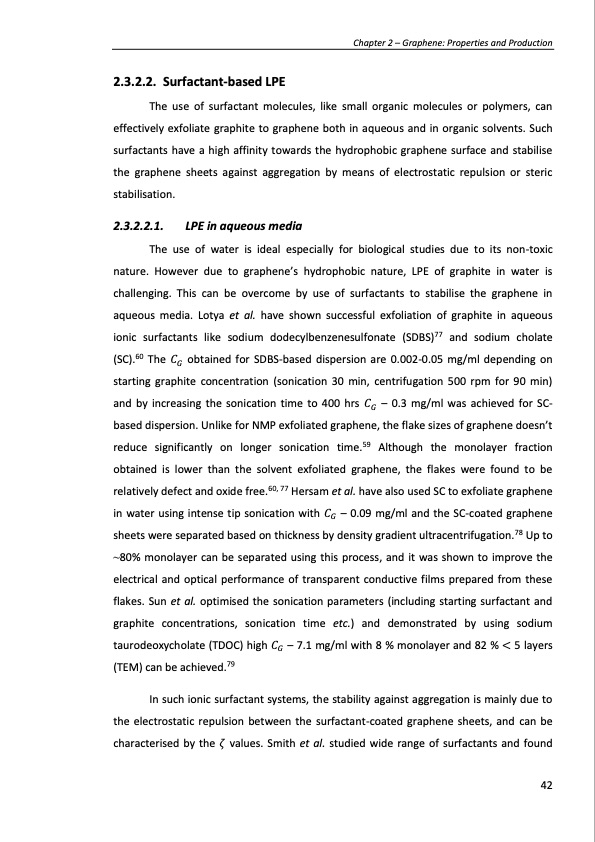
PDF Publication Title:
Text from PDF Page: 042
2.3.2.2. Surfactant-based LPE The use of surfactant molecules, like small organic molecules or polymers, can effectively exfoliate graphite to graphene both in aqueous and in organic solvents. Such surfactants have a high affinity towards the hydrophobic graphene surface and stabilise the graphene sheets against aggregation by means of electrostatic repulsion or steric stabilisation. 2.3.2.2.1. LPE in aqueous media The use of water is ideal especially for biological studies due to its non-toxic nature. However due to graphene’s hydrophobic nature, LPE of graphite in water is challenging. This can be overcome by use of surfactants to stabilise the graphene in aqueous media. Lotya et al. have shown successful exfoliation of graphite in aqueous ionic surfactants like sodium dodecylbenzenesulfonate (SDBS)77 and sodium cholate (SC).60 The 𝐶𝐺 obtained for SDBS-based dispersion are 0.002-0.05 mg/ml depending on starting graphite concentration (sonication 30 min, centrifugation 500 rpm for 90 min) and by increasing the sonication time to 400 hrs 𝐶𝐺 – 0.3 mg/ml was achieved for SC- based dispersion. Unlike for NMP exfoliated graphene, the flake sizes of graphene doesn’t reduce significantly on longer sonication time.59 Although the monolayer fraction obtained is lower than the solvent exfoliated graphene, the flakes were found to be relatively defect and oxide free.60, 77 Hersam et al. have also used SC to exfoliate graphene in water using intense tip sonication with 𝐶𝐺 – 0.09 mg/ml and the SC-coated graphene sheets were separated based on thickness by density gradient ultracentrifugation.78 Up to ~80% monolayer can be separated using this process, and it was shown to improve the electrical and optical performance of transparent conductive films prepared from these flakes. Sun et al. optimised the sonication parameters (including starting surfactant and graphite concentrations, sonication time etc.) and demonstrated by using sodium taurodeoxycholate (TDOC) high 𝐶𝐺 – 7.1 mg/ml with 8 % monolayer and 82 % < 5 layers (TEM) can be achieved.79 In such ionic surfactant systems, the stability against aggregation is mainly due to the electrostatic repulsion between the surfactant-coated graphene sheets, and can be characterised by the 𝜁 values. Smith et al. studied wide range of surfactants and found Chapter 2 – Graphene: Properties and Production 42PDF Image | PRODUCTION AND APPLICATIONS OF GRAPHENE AND ITS COMPOSITES

PDF Search Title:
PRODUCTION AND APPLICATIONS OF GRAPHENE AND ITS COMPOSITESOriginal File Name Searched:
graphene-production-applications.PDFDIY PDF Search: Google It | Yahoo | Bing
Salgenx Redox Flow Battery Technology: Power up your energy storage game with Salgenx Salt Water Battery. With its advanced technology, the flow battery provides reliable, scalable, and sustainable energy storage for utility-scale projects. Upgrade to a Salgenx flow battery today and take control of your energy future.
| CONTACT TEL: 608-238-6001 Email: greg@infinityturbine.com | RSS | AMP |